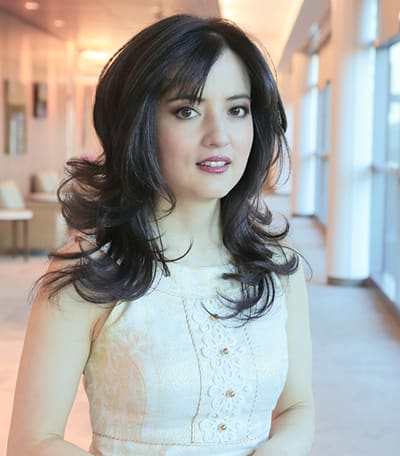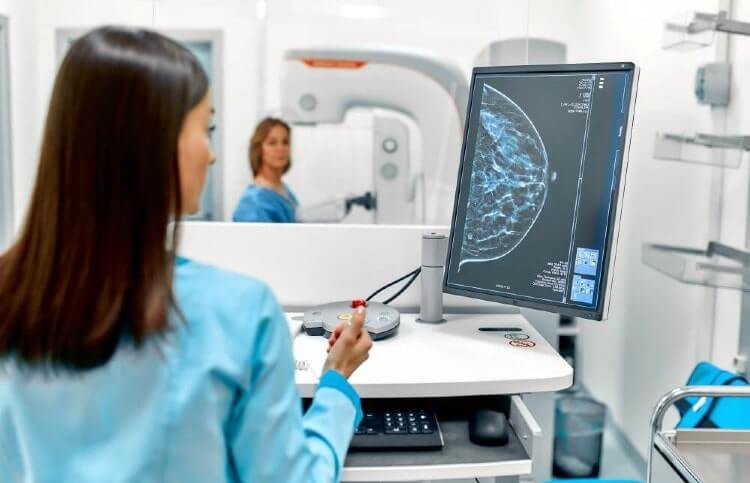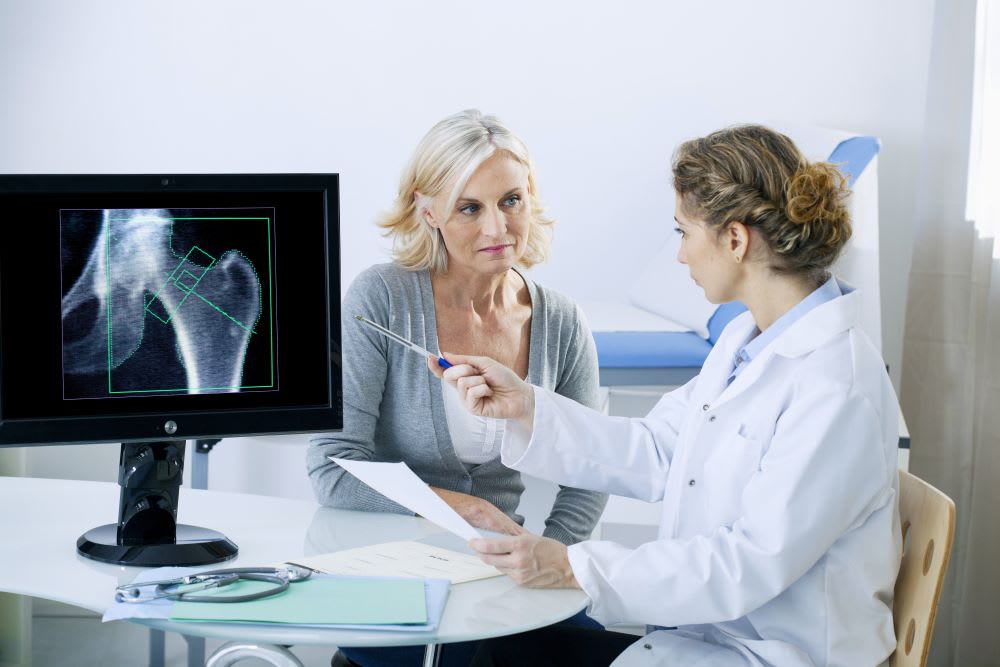The U.S. Preventive Services Task Force’s (USPSTF) latest announcement about when women should start breast cancer screening is a big deal. But it also falls short.
• Recommending that women aged 40 to 74 undergo breast cancer screening every other year, instead of annually.
• Stating that more studies are needed to see how additional screening with ultrasound and MRI may help women with dense breasts.
• Making age 74 the cut off for bi-annual screening.
We want all average risk women ages 40 and older to have a yearly mammogram, because the benefits outweigh the risks. The USPSTF’s recent guidance, which entails breast cancer screening every two years, may be an attempt to avoid “over diagnosing,” or diagnosing a condition that would never have caused symptoms or problems. We have no way of knowing what cancers will stay stagnant and which will be aggressive in any one individual patient. Our goal is to find cancers as early as possible, when they are best treated.
In the interval between two years, any cancer can grow and spread. And breast cancer, once it grows, can spread from the breast ducts to the tissue to become invasive, and then to the lymph nodes and beyond. It’s the size of the cancer and whether it spreads to the lymph nodes that most impact breast cancer mortality. Yearly screening can find cancer when it’s the smallest to potentially save a woman’s life.
The main risk factors for breast cancer include being a woman, aging, genetic mutations, family history of breast or ovarian cancer, being overweight or obese, reproductive history (starting menstrual periods before age 12 and starting menopause after age 55 expose women to hormones longer, raising their risk of breast cancer), having dense breasts, and smoking and alcohol use. Other risk factors include history of biopsies and of breast cancer, and other factors that increase your estrogen exposure, such as certain estrogen-based hormone replacement therapies (HRT).
To determine your breast cancer risk — and whether you should start screening before age 40 — you should have a discussion with your doctor.
The American College of Radiology (ACR) and the Society of Breast Imaging (SBI) recommend that all women have a breast cancer risk assessment by age 25, and then discuss with their doctor whether earlier screening with mammography and/or MRI is needed. The ACR considers anything greater than 20% lifetime risk of breast cancer to be high risk and recommends high-risk women to undergo screening with MRI.
As far as screening for women with dense breasts, a mammogram may not be enough, since it cannot detect all breast cancers. This is why the ACR and SBI recognize ultrasound and MRI as being important tests to complement mammogram in women with dense breasts.
Although the USPSTF has caught up with other health organizations by lowering the age for breast cancer screening, it has come only halfway. Having an annual mammogram from age 40 on is the best way to reduce mortality and morbidity from breast cancer. Furthermore, supplemental screening with ultrasound or MRI is key in women with dense breast tissue. Finally, women should continue screening as long as they are in good health.
What are the 2024 breast screening guidelines from USPSTF?
The USPSTF’s recent guidance aligns with that of most major health organizations by recommending that all women start breast screening at age 40. This is a welcome shift from its previous recommendation that women start screening at age 50. Still, it falls short by:• Recommending that women aged 40 to 74 undergo breast cancer screening every other year, instead of annually.
• Stating that more studies are needed to see how additional screening with ultrasound and MRI may help women with dense breasts.
• Making age 74 the cut off for bi-annual screening.
We want all average risk women ages 40 and older to have a yearly mammogram, because the benefits outweigh the risks. The USPSTF’s recent guidance, which entails breast cancer screening every two years, may be an attempt to avoid “over diagnosing,” or diagnosing a condition that would never have caused symptoms or problems. We have no way of knowing what cancers will stay stagnant and which will be aggressive in any one individual patient. Our goal is to find cancers as early as possible, when they are best treated.
In the interval between two years, any cancer can grow and spread. And breast cancer, once it grows, can spread from the breast ducts to the tissue to become invasive, and then to the lymph nodes and beyond. It’s the size of the cancer and whether it spreads to the lymph nodes that most impact breast cancer mortality. Yearly screening can find cancer when it’s the smallest to potentially save a woman’s life.
Who is at risk of developing breast cancer?
Breast cancer is the second most common cancer, and the second leading cause of cancer death in American women: 1 in 8 will receive a breast cancer diagnosis in their lifetime. Most breast cancers are found in women who are 50 or older, but breast cancer rates are rising in younger women. Black women have the nation’s highest death rates from the disease and are more likely than women from other racial or ethnic groups to have aggressive cancers when they’re younger. White women also have more aggressive cancers than women from other racial or ethnic groups, although minority women develop and die from the disease before age 50 more often than white women.The main risk factors for breast cancer include being a woman, aging, genetic mutations, family history of breast or ovarian cancer, being overweight or obese, reproductive history (starting menstrual periods before age 12 and starting menopause after age 55 expose women to hormones longer, raising their risk of breast cancer), having dense breasts, and smoking and alcohol use. Other risk factors include history of biopsies and of breast cancer, and other factors that increase your estrogen exposure, such as certain estrogen-based hormone replacement therapies (HRT).
The USPSTF’s guidance applies to women with a “family history,” but what does this mean?
If you have a family history of breast cancer, then you may want to undergo genetic testing to see if you carry an inherited mutation in the BRCA1 or BRCA2 gene, which is the most common cause of hereditary breast cancer. If you are considered high-risk, then you may also benefit from supplemental screening tests like magnetic resonance imaging (MRI) or ultrasound. Stamford Health offers a High-Risk Program to help you stay on track of breast screenings.To determine your breast cancer risk — and whether you should start screening before age 40 — you should have a discussion with your doctor.
The American College of Radiology (ACR) and the Society of Breast Imaging (SBI) recommend that all women have a breast cancer risk assessment by age 25, and then discuss with their doctor whether earlier screening with mammography and/or MRI is needed. The ACR considers anything greater than 20% lifetime risk of breast cancer to be high risk and recommends high-risk women to undergo screening with MRI.
As far as screening for women with dense breasts, a mammogram may not be enough, since it cannot detect all breast cancers. This is why the ACR and SBI recognize ultrasound and MRI as being important tests to complement mammogram in women with dense breasts.
Although the USPSTF has caught up with other health organizations by lowering the age for breast cancer screening, it has come only halfway. Having an annual mammogram from age 40 on is the best way to reduce mortality and morbidity from breast cancer. Furthermore, supplemental screening with ultrasound or MRI is key in women with dense breast tissue. Finally, women should continue screening as long as they are in good health.
Featured Expert/ Author



























